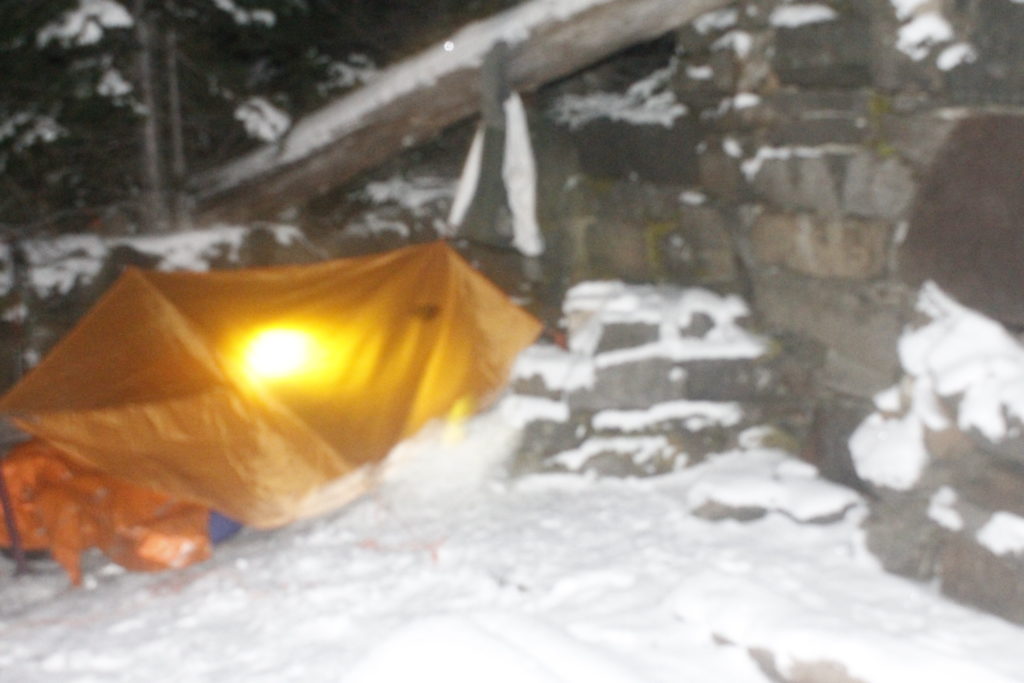
I have this fantasy that one day I will become a Master of Gear.
The Master Of Gear knows exactly what to bring on any given trip, can effortlessly summon shelter, fire, warmth and dryness against the hostile elements. He or she can produce a cup of hot tea to warm your numb fingers, deflect windblown snow with a handy tarp, will always have an extra dry pair of socks, puts on a waterproof layer before the rain starts, wears exactly the right amount of clothes, is never cold, never sweats and has a pack that is much lighter than yours. Nothing is unnecessary.
You will look at your too heavy tent, ripped sleeping bag, the rag-tag assortment of bent stakes and garbage bags, remember that the gloves you need are in the bottom of your pack and feel like the amateur you are. Why do you even try? You’ll never get it right.
And yet I keep striving to get better and to become more fluent in the little tricks and beats that make up the rhythm of hiking, especially if I happen to be traveling with a significant other, especially if I’d talked big game earlier.
When Lauren had said she was looking to buy a tent for herself, I told her that she might save money and weight by choosing a lightweight tarp instead.
“They are better than tents in some ways,” I remember saying with conviction. “You can cook inside them without poisoning yourself with carbon monoxide, the ventilation will reduce the amount of moisture inside.”
I went on about how a cheap lightweight bivy sack could provide wind protection to the sleeping bag, how I had a friend who’d hiked the Appalachian Trail under a tarp, how explorers had even used them for winter camping.
Lauren was skeptical. Then she saw a tarp that weighed just over a pound going for $24 online. She went for it.
Not one to step down from a challenge, I suggested that we try it out on a November camping trip in the Olympic Mountains.
That is how we ended up hiking up along the Heather Park Trail on our way to a 5,300-foot campsite.
If I am not yet Master of Gear, I try to at least become Moderately Capable Guy.
As such, I have a couple of OK tricks in the bag. such as keeping a small piece of insulated mat at the outside of my pack. This enabled us to take a quick sit-down break on the side of the trail without getting our butts wet or cold. I’ve also taken to hiking with food and water in my jacket pockets to make it easier to access the basics when needed. Some “extras” that I brought along included crampons, if I wanted to mess around on hard-packed slopes up higher, an ice axe and a ski pole with ice axe attachment.
A quick sip of water was in order after a couple of hours (and 2,000 feet) of climbing up the trail. The lush environment that we had started in had given way to thinner trees, with many fallen trunks strewn about the mountain side. A fine dusting of snow was on the ground, a cold bite was in the air.
An opening in the trees led to a ledge, where Lauren and I could step out and look at Port Angeles Harbor, where gigantic cargo ships at anchor looked like rectangular islands. To the west, I traced the land to Protection Island and near the harbor of Port Townsend.
A mere 15 miles (give or take) out I saw Vancouver Island, Canada. Though I can see the island on any clear day from Port Angeles, it usually looks like a two-dimensional strip of hills and mountains. From on high, I could see beyond Victoria into the heartland of the enormous chunk of land (the largest island in the eastern Pacific) to the intricate passages off its eastern coast and over to vast inland lakes.
Our break went before another mile of steep hiking where the powdered snow got a couple inches deep. Later, we came to a stream and an abandoned foundation for a hiker hotel. The builders had abandoned their project long ago, but left a footprint for two weary travelers to set up tarp.
I let Lauren get water for our dinner while I bravely took on the challenge of putting up our shelter.
The tarp to tent substitution is something that I have tried at different times over the years, with varying degrees of success. I went for a walk down memory lane through some of my older blogs and concluded that something usually sucks about every tarp I’ve built. Here’s how I describe one night in the Black Hills four years ago:
Now that I had some tiny cocoon of body heat, I was damn reluctant to get up and fool around in the rain trying to adjust my demented shelter while getting everything soaked in the process. Instead, I forced myself into the fetal position, trying to think happy thoughts and reflect on all that valuable wilderness experience that I was getting.
And now I was subjecting my girlfriend to this?
But, hey, the tarp shelter that I’d built back in July had worked out decently enough. The shelter of the foundation gave me confidence too.
First, I kicked away the snow from the place where we would be sleeping, and swept it clear with a pine bough.
I tied one end of a rope to a tree branch where the foundation walls formed a corner and tied the other end to the head of my ice axe, which I sank into the dirt further away. This place, I was sure, would provide plenty of protection. I placed the tarp over the rope and secured the corners down with stake. I secured other corners down with two other tree branches and a piece of metal within a fireplace. I hauled off on knots so that I could make everything tight as possible.
Lauren came back to see a hodgepodge of ropes and knots, me still fiddling to get stakes in the semi-frozen ground.
“This is taking forever. Maybe we should have just brought a tent.”
“Nonsense. This is under control. I’m just a little rusty at tarp set up. It takes awhile.”
Eventually, I had everything into a crude, but workable shelter for us to put our pads and sleeping bags. Next, we folded our sleeping bags into lightweight, reflective bivy sacks that would hold in heat and shield us from the elements. Lauren’s feet were cold, so I took a moment to warm them on my belly, and then she got herself settled into her bag. I knew that if we were low on calories, it would be harder for both of us to maintain core temperature. A hot dinner was an obvious priority.
I took a bathroom break shortly before dinner, making sure to move a good distance away from the shelter. The last thing I wanted was the scent of urine drawing unwelcome visitors: mountain goats.
Hunters in the early 20th century saw the bold crags of the Olympic Mountains, the green blue waters of glacial lakes and gushing rivers and thought, “What this place really needs are some new large animals for us to shoot.”
Never mind that the fragile ecosystems in the Olympic Mountains developed without the large disruptive herbivores foraging the vegetation, and beating paths through the brush. The Cascade Mountains, not far away, did have mountain goats and it was easy enough to truck them over. The relocated goats did find the new environment to their liking. Unfortunately, for the hunters, their dreams of open goat season went off the table once the Olympics became national park in 1938. The shaggy beasts were left to stalk over the rocks and ridges to forage on the alpine plants and thrive in their new environment.
Even if these goats were bad for the mountains, I can’t deny that I would have loved to have seen some of these majestic creatures in their element. I’ve always admired their ability to leap gracefully along the sides of sheer cliffs. The sure-hoofedness of the animals would have been a spectacle to behold — though hopefully from a distance.
Goats are known to have a territorial streak. They can get stand-offish. Since they also can weigh hundreds of pounds and have large pointy horns on their heads, this can be dangerous. The one recorded animal fatality in Olympic National Park was the result of a goat charge near Hurricane Ridge.
It would seem logical for humans exploring the Olympics to try to avoid goat encounters, but unfortunately, human activities will attract goats. They seek out human sweat and urine because of its salt content. The Park Service encourages people to pee away from trails so that the goats don’t hang out there.
I had a ranger tell me the troubles of one unfortunate hiker who had set his sweaty shirt down in goat country. He must have walked away or else have been pretty unobservant, because a goat gobbled it up. Bummer.
Later, the goat decided the shirt wasn’t its style and regurgitated it back up. That was “lucky” for the hiker, who only had only brought one shirt into the cold, mountainous area. He put it back on and wore his newly-moistened garb the rest of the hike out.
For those of us unlucky enough to have a close goat encounter, the rangers have advised yelling and throwing rocks.
The advice changes during mating season, to “Stay out of the goats’ way,” — according to the same ranger who told me about the shirt-eating incident.
This time of year is mating season, which means that any yelling or posturing at goats would probably threaten the manhood of the males — kind of like calling the biggest guy in the biker bar a pansy in front of his friends — with predictable, violent consequences. Better to move aside and act non-threatening.
As early as the summer, the Park Service still hadn’t have a definitive plan as to what to do with the goats inside the park. They are a popular sight for tourists and a majestic creature to boot. It just happens that they are in the wrong place, through no fault of their own.
One proposal is a relocation program that involves tranquilizing goats and trucking them back to the Cascades. Goats that evade capture will then face bullets from human hunters who will finally get to do what the people who brought the goats to the mountains had wanted to do in the first place.*
The fact that there may not be goats in the Olympics someday soon only made me want to see a goat even more. Again, I should reemphasize that I only want to see this goat on my own terms. A pee-seeking goat stomping around the campsite was not what I had in mind.
I put aside goat thoughts and went back to food.
The chef’s special of the evening included split pea soup made from dehydrated flakes I’d brought from a natural food store earlier.
Lauren got my stove running from her sleeping bag and we got water up to boil. The flakes cooked in no time and soon we had a meal that could put some warmth back in our guts . The fact that we could cook this meal from inside our shelter was a definite plus. If we had been tent-camping, I would have set the stove outside in the raw elements so as not to burn the tent down or kill us with carbon monoxide. Score for the tarp tent!
The stove added warmth and a little moisture to our small shelter. Little beads formed on the inside of the tarp that would surely freeze later.
Spanish rice followed the pea soup. I added a tube of tomato paste for additional flavor. The heat was great for us, but Lauren’s feet were getting cold again.
I saw the obvious solution in an empty peanut jar I’d brought along. It could make a great hot water bottle. I boiled another pot of water and poured it in. While I had done this before with Nalgene bottles and aluminum, the heat of boiling water was too much for the thin plastic canister and it melted the top of the jar, rendering the screw top completely useless.
I cursed mightily at the spilled water and at myself. Why did I have to fill the jar to the very top? Why did I have to put completely boiling water in there?
The spill had moved toward Lauren’s sleeping area, but we were able to swipe it away before it did real harm. It had left a salty residue that goats might be interested in. I was bummed that I wasn’t able to help with Lauren’s feet. The whole thing felt like a bad omen for the oncoming night.
I gathered the remains of dinner back in the bear can and walked it up the trail to where it would be away from our tent. I took one last pee before I went back to the tent area. I had no interest in leaving my sleeping bag until morning.
Night time in a sleeping bag is the perfect time to wander into that half-sleep of speculation. Is that noise the wind jostling the branches, or is it a massive horned animal stalking the woods for urine deposits? Maybe the strange slits of its pupils were glowing red with malicious inner light.
And, hey, maybe it wants to kill you.
It is not difficult to imagine bad intentions from the beast with cloven hooves.
“Did you hear something?” Lauren asked.
“Hmmm. It probably wasn’t anything.” I said. I moved my ski pole with the ice axe closer to my sleeping bag.
I drifted back toward almost sleep until I heard a scuff, or maybe it was a sneeze.
Lauren: “What was that?”
I peeked over the flapping tarp, saw nothing in the darkness.
“Not sure,” I said.
The demons were toying with us, no doubt.
Sometimes music is the best remedy in times of stress, and I channeled the Rolling Stones.
“Wiiyiilld mountain goats …. couldn’t butt me to death.”
But maybe it was the wind that was going to do us in. Katabatic winds are common in the mountains, especially around coastal ranges like the Olympics. What happens is the warm air that rose to the higher elevations in the day time, begins to condense on the cold mountainside come nightfall. Then that colder, denser air begins falling down the mountains, producing intense wind gusts.
Not long after I got into my bag, a sigh went through the trees, and then the tarp began flapping around like the dickens. The moisture from our cooking and our breath now formed a frosty layer that the wind beat away like dust out of a carpet. Each gust of wind brought a little sprinkle of this icy stuff down onto our faces. Then the wind would stop or I’d here it blowing on some other part of the mountain, I would start to feel myself drifting back toward sleep and the wind would come back. It always came back.
I pictured the wind twisting effortlessly over the rock wall and swiping its cold fury over us. I cursed myself for not putting the tent right up into the corner. Right now, the wall was accomplishing next to nothing.
Plus, the knots that I had used to lash the tarp tightly together were coming loose, and the structure flapped nastily. Reviewing the flaws in my structure, made me feel like no Master of Gear, but perhaps the Master’s dull student who hadn’t done his homework.
“You should lower the front, so the wind doesn’t get in so much,” Lauren said.
The idea made sense, although, I had to get half out of my sleeping bag to make it work. I reluctantly untied the guy-lines from the fixed objects in the front and staked them into the ground. This did lower the wind profile of the tarp and it felt better inside. I clipped my pack into the center line also to make the shelter less apt to billow upward when the wind filled it. It also provided a partial wind barrier. Snowflakes were drifting into the shelter now.
I figured I’d done the best I could and rolled back over into my sleeping bag.
Sleep might have come then, but a few minutes later, the wind seemed to get much worse and the flapping louder.
“A tent stake came up!” Lauren announced. I could look up and see stars in the night sky. I cursed some more and got up to drive the stake back into the ground and reinforced it with a second stake in the same place. A while later, a different stake came up, and I had to reinforce that one too.
“Should we go back down the mountain?” Lauren asked.
I thought about getting out of the sleeping bag to reorganize everything for a trip out into that icy wind. I felt no great excitement at the prospect.
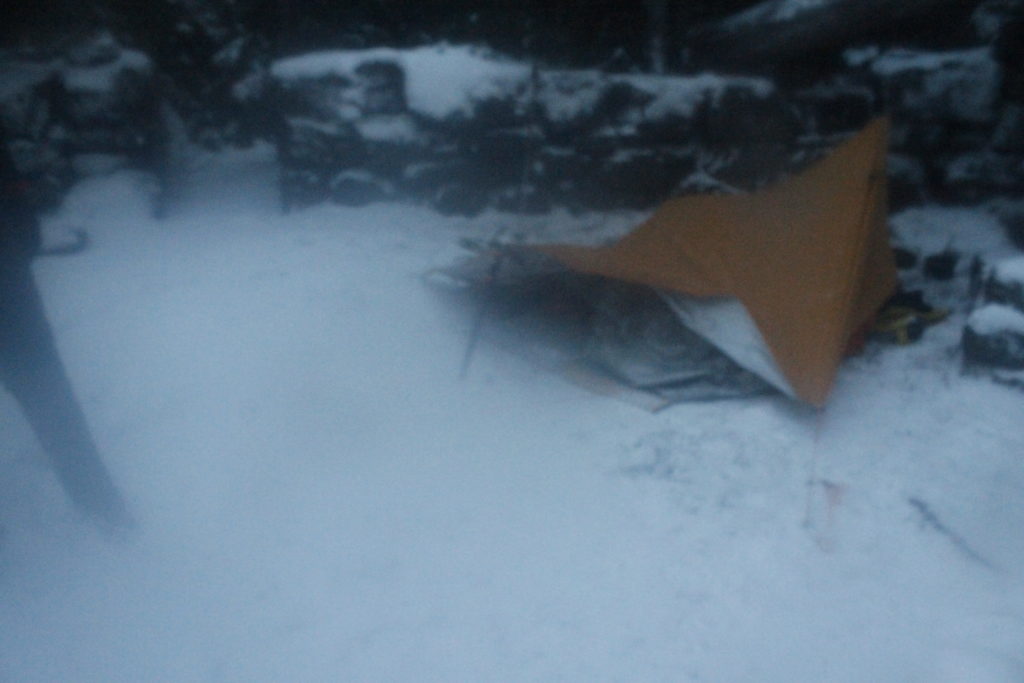
At least our bivy sacks gave us a greater level of protection than what we would have encountered in our sleeping bags alone. If a little snow got on us, it wouldn’t melt into our insulation.
Still, we were both getting plenty cold. It was about 4 a.m. now and my hope was that the sunrise would give us some renewed vigor. The path of least resistance, staying in place, felt like the way to go.
By some miracle, the rest of the stakes held through the night.
We stumbled out of our bags to fetch the bear can and to fill up water for breakfast.
Sure enough the warm food and hot coffee put life back into us. Better yet, there was light coming in through the clouds and a little warmth to go with it.
We dismantled shelter, packed our gear and headed up the trail.
Initially, Lauren had voted we go right back down to the car, but the promising weather had changed her mind. The scenery around Heather Park includes views of the jagged peaks around First Top and Second Top.
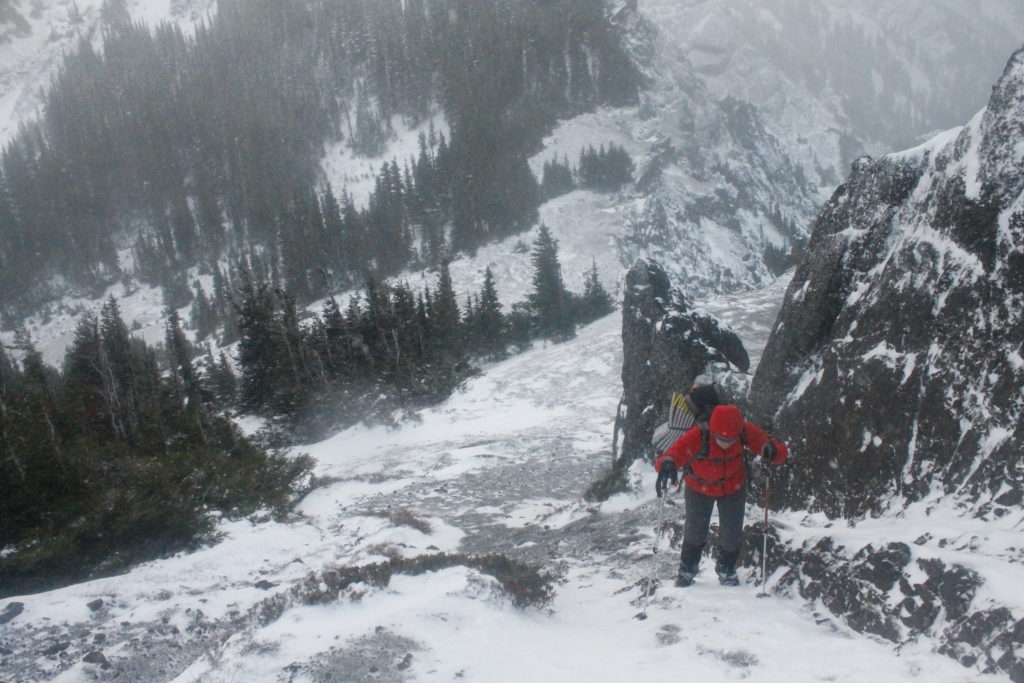
We wore gaiters to keep snow out of our boots, and Lauren had a pair of micro-spikes to improve her grip on the snow. My crampons stayed in the pack. For the moment, they were too heavy-duty for what we were dealing with.
The trail wound up a series of switch backs until we got to a ridge where we could look out toward the Mount Angeles ridge and Hurricane Hill. I could make out the pale, blue line of Lake Crescent. It looked like another beautiful day down there.
The scenery, Lauren said, was worth the brutal night. I breathed a sigh of relief. Not all of the gear had worked perfectly, but we had stayed in the game.
On high, the wind whipped like a banshee through the hills and the clouds raced above the jagged peaks at unnatural speed. We topped out at Heather Pass. There was an inhuman drama to the scene that appealed to me. I always remember how much I love mountains when I go up into them.
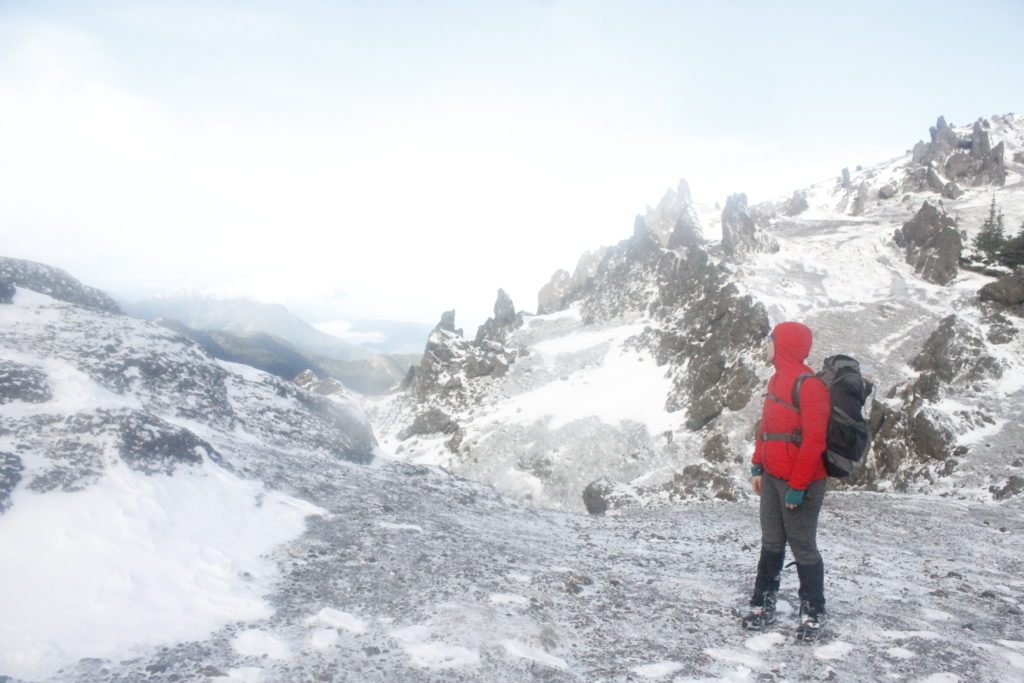
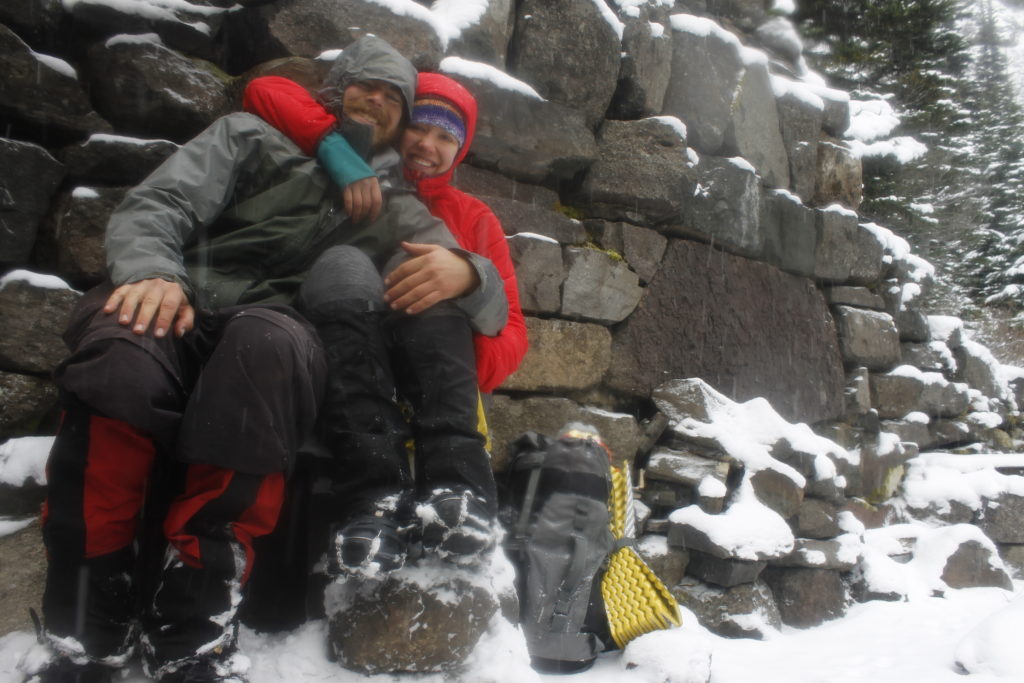
Before we went down to the lower elevations, we went up onto a higher ridge. I went ahead for the top, grabbing holds in the rock with the tips of my axes and pulling myself up. The effort rewarded me with a view of Port Angeles and the little toy boats moored in the harbor.
The ridge had something else: goat prints in the snow. Sometimes I followed in their tracks because they beat their way through the thickest brush. I had to hand it to them, thriving up in this freezing country without the sleeping bags, stoves, ice axes or tarps we humans were compelled to bring. If I had seen any of the rugged creatures roaming around, I might have asked how they pulled it off.
Alas, the hoof prints were the only sign. They kept themselves, and their secrets, hidden.
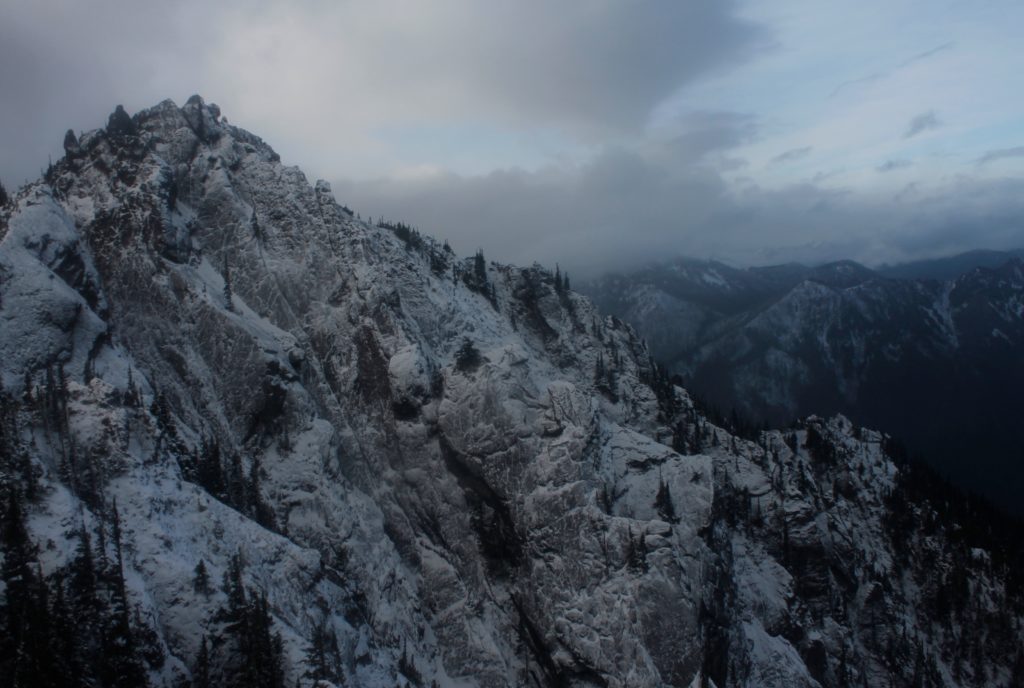
- Regarding mountain goat removal plans: I heard about the proposal from the ranger station, and wanted to do more research.The information I found online was sketchy, but there is a document here, that suggests a plan to get the goats out of the Olympic Mountains.https://parkplanning.nps.gov/projectHome.cfm?projectId=49246
